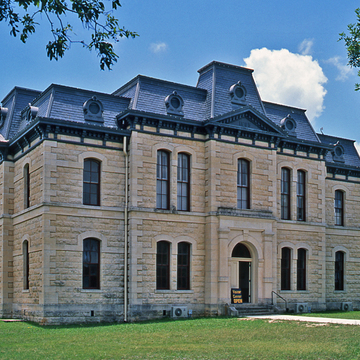You are here
Visitor Center (Blanco County Courthouse)
One of a number of more or less identical Texas courthouse designs by Frederick E. Ruffini, the courthouse is a rather simplified Second Empire design. Prior to this courthouse, he designed courthouses for Rusk County (1879) in Henderson, Navarro County (1881) in Corsicana, Hays County (1882) in San Marcos, and Williamson County (c. 1882) in Georgetown, none of which still stand. In 1885–1886, in collaboration with his brother Oscar, he designed Concho County Courthouse in Paint Rock. As is always the case with the work of the Ruffinis, the limestone facades are simply and effectively detailed with smooth-faced quoins and window surrounds contrasting with rock-faced walls. The interior of the courthouse has survived with few changes. The fine courtroom on the second floor has its original painted wooden ceiling and an over-scaled wood cove around the walls.
Writing Credits
If SAH Archipedia has been useful to you, please consider supporting it.
SAH Archipedia tells the story of the United States through its buildings, landscapes, and cities. This freely available resource empowers the public with authoritative knowledge that deepens their understanding and appreciation of the built environment. But the Society of Architectural Historians, which created SAH Archipedia with University of Virginia Press, needs your support to maintain the high-caliber research, writing, photography, cartography, editing, design, and programming that make SAH Archipedia a trusted online resource available to all who value the history of place, heritage tourism, and learning.















